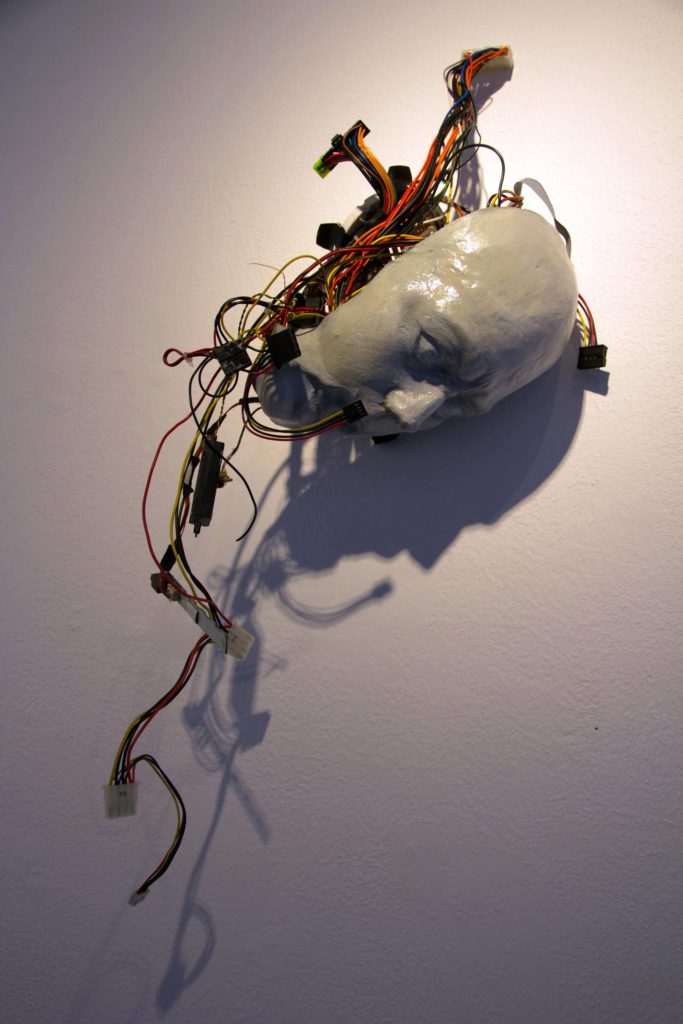
A half-formed face pieced together from scraps of clay stares at the blanched ceiling—voiceless yet unnerving. Its hollowed eyes gaze upward in a state of perpetual shock while its mouth—prodded and pulled out of alignment—hangs slack-jawed as if it were screaming. Like the many other sketches and sculptures that litter Naomi Nadreau’s modest home, the mask is a work in progress.
Above the face, left out to dry on Nadreau’s desk, hangs three sketches of street thugs wearing elaborate masks. It is baroque meets cyberpunk.
“They [the masks] have to be functional,” explains Nadreau, 22, as she repositions herself on the living room floor. “If they aren’t then there’s no point. In the world they live in, everything has to have a purpose. Nothing’s wasted.”
Nadreau is a junior in the Masters of Art program at Cal. State Northridge. Though she did not intend to pursue art as a career in her earlier years, it has become both her profession and obsession.
Her obsession has filled countless sketchbooks and has now begun to bleed out onto the parchment white walls of her apartment.
Interlaced together are black inked images of gangly pedestrians and the aptly named “Meat Men” carrying sacks of raw meat through city streets, dodging idling subway riders fitted with World War I era gas-masks.
Behind the busy metropolis is a vast expanse of dimly lit pillars that appear to be teetering on the edge of ruin.
“I’m drawing trash,” Nadreau says with a shy laugh. “Literally, everything in that picture is garbage. The buildings, the towers—all of it is made out of compact cubes of e-waste. And everyone that lives in that part of the city [and in the towers] has some kind of health condition or deformity from breathing in the toxins and fumes the garbage releases.”
The idea for the “Trash Towers,” as Nadreau calls them, came to her while researching disposal methods for electronic waste in the United States.
“The reason we [Americans] don’t have an e-waste problem is because all of it is shipped overseas,” Nadreau says. “The majority of used electronics we throw away are dumped in landfills in China and India because it is easier for big corporations and it doesn’t cost them as much as it would to properly dispose of it here [in the United States].”
An investigative report released in 2016 by American environmental watchdog group, Basel Action Network, echoed Nadreau’s concerns. According to the report, the majority of American e-waste is shipped to China and Hong Kong. Other deposits from the states can be found in landfills in Mexico, Pakistan, and Thailand.
The reports state that fires are a permanent fixture at the recycling fields. Black plumes of smoke streak across blue skies filling the air with toxic fumes released from the burning scraps of junk left behind by scavengers. Nothing—not even weeds—can grow because the soil is saturated with hazardous chemicals that have oozed out of the aging electronic heap. Entire families can be found riffling through mountains of computers and unwanted iPhones—dismantling them piece by piece for valuable parts.
This present-day dystopian world also played as the backdrop for the short film Nadreau provided services for that would later fuel her in other endeavours.
University of California, Los Angeles graduate Aaron Isaacs began production on And Upside Down In The Sky Were Towers in 2010. The neo-western silent film plays with the idea of what the planet’s future would be if technology and underhanded politics formed a union.
Isaacs, 24, chose Nadreau to spearhead the set design and props department.
“Naomi [Nadreau] went far beyond my expectations for the movie,” Isaacs says. “It was a massive undertaking because there were only two people in the department, but she really took charge and brought the world from my script to the screen.”
Like the scavengers riffling through the landfills in India, Nadreau pilfered back alley dumpsters loaded with wasted tech pieces and pillaged scrapyards for props. For certain shots, like those inside a tinker’s shop, Nadreau had to construct working models of prosthetic limbs, clocks and other miscellaneous gadgets.
Apart from set construction and design, she was tasked with creating a holographic interface.
“One of the main characters [in Towers] is a scientist and he has this office in his home that he works out of,” Nadreau says. “When I was told about the character I knew that his workspace had to be practical. So I designed it like a filing system you’d find in a computer. It’s functional and the information can be accessed quickly, which matches the character’s line of work.”
Before she decided to nurture her passion, Nadreau dabbled in the physical sciences. As the daughter of a nurse, she had always experienced a level of pressure to follow in her mother’s footsteps. After taking a number of courses in medicine, Nadreau knew she could not part with her first love.
“My mother wasn’t very happy about it when I told her I was changing my major,” Nadreau admits. “It was hard for her and part of it is that I feel like she wants me to have a good future.”
Following the revelation, Nadreau committed herself to her work. While the sources of inspiration may be in a constant state of flux, she has always had an eye for the morbid, a little strange and surreal.
“I watch a lot [of Stanley] Kubrick’s films and those have really played into the futuristic idea I have going on,” Nadreau says. “Elon Musk has been a huge influence too.”
Mixing the darker themes from shows like Psycho-Pass and Ghost In The Shell with her background in anatomy and a wealth of economic knowledge, Nadreau carves her way through projects with a signature flair.
Though her pieces are not an outright political commentary, they speak volumes of the world she sees through her eyes. This mentality is one that many other denizens of the profession share.
Melody Cooper, professor of art and the department chair of art and architecture, has been teaching at Pierce College since spring 2000. In her tenure, she has taught an array of students with vastly different personalities. And while no two people are alike, Cooper has learned that they all share one commonality.
“I think that one of the things at sets them [artists] apart is their courage to bare their soul in front of people, because when you’re doing your artwork, it’s a reflection of your personality,” Cooper says. “When you do artwork, it’s an autobiography. Putting it out there for people to criticize, it is a very tenuous position.”
While Cooper makes a point to try to work when she is happy, the professor admits that some of an artist’s best pieces are produced during time of hardship.
“I think that when a person has a bit more adversity in their life, it does improve artwork. You can approach it from a joyful standpoint, which is what I try to do. But it’s much more cathartic when you have an issue because it is a way to express it,” Cooper says.
Similarly, Nadreau produces the lion’s share of her work when she needs a relief. During high school and early on in college when she felt the strain of her mother bearing down, Nadreau immersed herself in her sketchbooks and the world’s that filled them.
During this time of soul searching, Nadreau’s personality developed into the more “quirky, intellectual thinker” her friends know her to be now.
“Naomi was very shy at first. I met her through my girlfriend who was a high school friend of hers. I didn’t really get to know Naomi until later on in college,” Isaacs says. “She’s a fun person to be around and has a calmness to her which makes her approachable.”
This demeanor has helped Nadreau wade through college life and also as a teacher at the KidsArt in Northridge. Though it is her job to lead and inspire the children that come into the center, Nadreau finds herself encouraged by them.
“The kids can be a handful at times and keep me on my toes,” Nadreau smiles. “But it’s fun and they always have something new they want to draw.”
Like to Nadreau and her students, Cooper believes that the mistakes an artist makes are their best teacher. While there are so many things that can go wrong in the world of art during the creating stage, it is that “one success out of a hundred failures” that makes it worth it.
“There are so many parts that are seductive and so many parts that are just aggravating,” Cooper chuckles. “There’s also this camaraderie in the community that you don’t really find anywhere else. Those few successes and the people who can share in those triumphs are what make you come back.”



